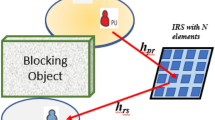Abstract
Position of the primary user is significant to the transmission among secondary users in cognitive networks (CN). In this paper, orthogonal frequency division multiplexing (OFDM)-based spectrum allocation and time of arrival-based localization are proposed for the devised CN. Crame–Rao lower bound for range estimation is theoretically derived in terms of the proposed spectrum allocation in CN, compared with that of the nonoverlapped allocation in CN and OFDM-based static spectrum allocation in noncognitive networks (NCN). The 2D localization accuracy is investigated based on horizontal dilution of precision (HDOP). The theoretical minimum HDOP is explored and the corresponding network topology to attain the minimum HDOP is provided. Theoretical analysis and simulation results demonstrate that the proposed spectrum allocation in CN exhibits a much better ranging and localization accuracy, and a better data transmission rate than the nonoverlapped spectrum allocation in CN, no matter the designed spectrum with nonoverlapped allocation is a sinc function or a rectangle. Also, the proposed spectrum allocation in CN is demonstrated to have a better ranging and localization accuracy than OFDM-based static spectrum allocation in NCN.
Similar content being viewed by others
References
Weiss T. A., Jondral F. K. (2004) Spectrum pooling: An innovative strategy for the enhancement of spectrum efficiency. IEEE Communications Magazine 42(3): S8–S14
Thomas, R. W., Da Silva, L. A., MacKenzie, A. B., et al. (2005). Cognitive networks. In Proceedings of IEEE international symposium on new frontiers in dynamic spectrum access networks (pp. 352–360).
Gong, D., Ma, Z., Li, Y., Chen, W., Cao, Z., et al. (2008). High order geometric range free localization in opportunistic cognitive sensor networks. In Proceedings of IEEE international conference on communations (pp. 139–143).
Urruela A., Sala J., Riba J. (2006) Average performance analysis of circular and hyperbolic geolocation. IEEE Transactions on Vehicular Technology 55(1): 52–66
Sayed A. H., Tarighat A., Khajehnouri N. (2005) Network-based wireless location: Challenges faced in developing techniques for accurate wireless location information. IEEE Signal Processing Magazine 22(4): 24–40
Gustafsson F., Gunnarsson F. (2005) Mobile positioning using wireless networks: Possibilities and fundamental limitations based on available wireless network measurements. IEEE Signal Processing Magazine 22(4): 41–53
Do, J., Rabinowitz, M., Enge, P., et al. (2006). Performance of TOA and TDOA in a non-homogeneous transmitter network combining GPS and terrestrial signals. In Proceeding of ION National Technical Meeting (pp. 642–649).
Guvenc I., Chong C. (2009) A survey on TOA based wireless localization and NLOS mitigation techniques. IEEE Communications Surveys and Tutorials 11(3): 107–124
Kim, S., Jeon, H., Ma, J., et al. (2007). Robust localization with unknown transmission power for cognitive radio. In Proceedings of IEEE military communication conference (pp. 1–6).
Wang D., Fattouche M. (2010) OFDM transmission for time-based range estimation. IEEE Signal Processing Letters 17(6): 571–574
Wang D., Fattouche M. (2010) Multipath mitigation for LOS TBRE using NDB OFDM transmission and phase correlation. IET Electronics Letters 46(21): 1467–1468
Zhao G., Wang D., Fattouche M. (2011) Time sum of arrival based BLUE for mobile target positioning. Advanced Scienced Letters 4(1): 165–167
Zhao, G., Wang, D., Fattouche, M., et al. (2011). Novel wireless positioning system for OFDM-based cellular networks. IEEE Systems Journal (accepted).
Kay S. M. (1998) Fundamentals of statistical signal processing: Estimation theory. Prentice-Hall PTR, Upper Saddle River, NJ
Sang-Seon, B., Balasingham, I., Liang, X., et al. (2008). Dynamic spectrum allocation in wireless cognitive sensor networks: Improving fairness and energy efficiency. In Proceedings of IEEE vehicular technology conference (pp. 1–5).
Athley F. (2005) Threshold region performance of maximum likelihood direction of arrival estimators. IEEE Transactions on Signal Processing 53(4): 1359–1373
Author information
Authors and Affiliations
Corresponding author
Rights and permissions
About this article
Cite this article
Wang, D., Leung, H., Fattouche, M. et al. Efficient Spectrum Allocation and Time of Arrival Based Localization in Cognitive Networks. Wireless Pers Commun 66, 813–831 (2012). https://doi.org/10.1007/s11277-011-0365-9
Published:
Issue Date:
DOI: https://doi.org/10.1007/s11277-011-0365-9




